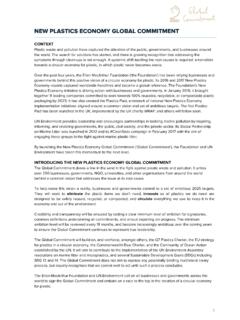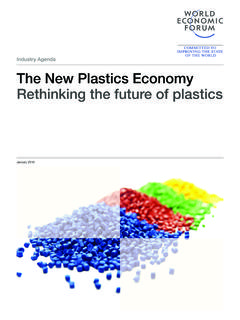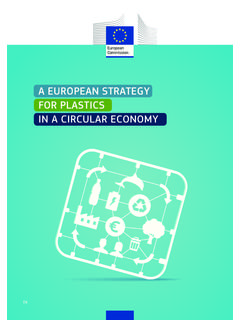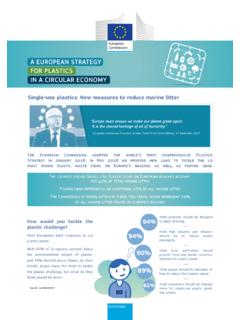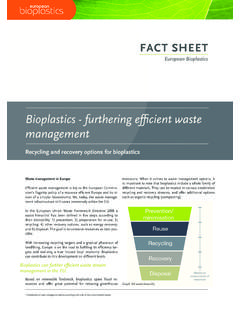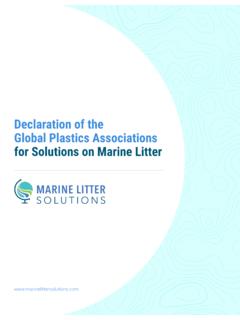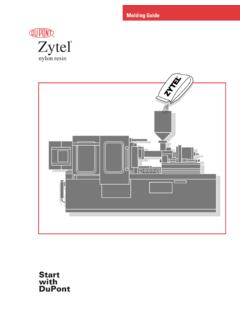Transcription of THE NEW PLASTICS ECONOMY RETHINKING THE FUTURE …
1 THE NEW PLASTICS ECONOMY 1 The New PLASTICS EconomyRethinking the FUTURE of PLASTICS THE NEW PLASTICS ECONOMYRETHINKING THE FUTURE OF PLASTICSTHE NEW PLASTICS ECONOMYRETHINKING THE FUTURE OF PLASTICS2 THE NEW PLASTICS ECONOMYTHE NEW PLASTICS ECONOMY 3 CONTENTSP reface 4 Foreword 5In support of the New PLASTICS ECONOMY 6 Project MainStream 8 Disclaimer 9 Acknowledgements 10 Global partners of the Ellen MacArthur
2 Foundation 14 EXECUTIVE SUMMARY 15 PART I SUMMARY OF FINDINGS AND CONCLUSIONS 221 The case for RETHINKING PLASTICS , starting with packaging 242 The New PLASTICS ECONOMY : Capturing the opportunity 313 The New PLASTICS ECONOMY demands a new approach 39 PART II CREATING AN EFFECTIVE AFTER-USE PLASTICS ECONOMY 444 Recycling: Drastically increasing economics, uptake and quality through compounding and mutually reinforcing actions 465 Reuse: Unlocking material savings and beyond 626 Compostable packaging: Returning nutrients to the soil for targeted packaging applications 68 PART III DRASTICALLY REDUCING LEAKAGE OF PLASTICS INTO NATURAL SYSTEMS AND MINIMISING OTHER EXTERNALITIES 747 Drastically reducing leakage into natural systems and associated negative impacts 768 Substances of concern.
3 Capturing value with materials that are safe in all product phases 79 PART IV DECOUPLING PLASTICS FROM FOSSIL FEEDSTOCKS 869 Dematerialisation: Doing more with less plastic 8810 Renewably sourced PLASTICS : Decoupling PLASTICS production from fossil feedstocks 92 Appendices 97 Appendix A. Global material flow analysis: Definitions and sources 98 Appendix B. Biodegradation 100 Appendix C.
4 Anaerobic digestion 101 Glossary 102 List of Figures and Boxes 105 Endnotes 106 About the Ellen MacArthur Foundation 1174 THE NEW PLASTICS ECONOMYPREFACEThe circular ECONOMY is gaining growing attention as a potential way for our society to increase prosperity, while reducing demands on finite raw materials and minimising negative externalities.
5 Such a transition requires a systemic approach, which entails moving beyond incremental improvements to the existing model as well as developing new collaboration report explores the intersection of these two themes, for PLASTICS and plastic packaging in particular: how can collaboration along the extended global plastic packaging production and after-use value chain, as well as with governments and NGOs, achieve systemic change to overcome stalemates in today s PLASTICS ECONOMY in order to move to a more circular model? The New PLASTICS ECONOMY aims to set an initial direction and contribute to the evidence base by synthesising information from across many dispersed sources.
6 It assesses the benefits and drawbacks of plastic packaging today, and makes the case for RETHINKING the current PLASTICS ECONOMY . It lays out the ambitions and benefits of the New PLASTICS ECONOMY a system aiming to achieve drastically better economic and environmental outcomes. It proposes a new approach and action plan to get there. The report s objective is not to provide final answers or recommendations. Rather, it aims to bring together for the first time a comprehensive global perspective of the broader plastic packaging ECONOMY , present a vision and propose a roadmap as well as a vehicle for progressing this roadmap, and providing a much needed global focal point to carry this agenda forward.
7 This report also identifies a number of significant knowledge gaps and open questions that need to be further explored. This report is the product of Project MainStream, an initiative that leverages the convening power of the World Economic Forum, the circular ECONOMY innovation capabilities of the Ellen MacArthur Foundation, and the analytical capabilities of McKinsey & Company. We are grateful to our numerous partners and advisors for their insights and support throughout this project, and the Project MainStream Steering Board for their continued collaboration on the transition towards a circular ECONOMY .
8 For the three institutions that have launched the MainStream initiative, this report is an encouragement to continue to foster cross-industry collaboration as a major avenue to accelerate the transition to the much-needed circular ECONOMY . We hope you find this report informative and useful. We invite you to engage with us on this timely Ellen MacArthurFounder, Ellen MacArthur Foundation Dominic WaughrayHead of Public Private Partnership,World Economic ForumMartin R. Stuchtey Director of the McKinsey Center for Business and EnvironmentTHE NEW PLASTICS ECONOMY 5 FOREWORDH.
9 E. Mogens LykketoftPresident of the UN General Assembly for the 70th sessionWe live in a defining moment in history a moment where the international community has come together to agree on an ambitious framework to resolve some of the world s most daunting in a set of universally applicable Sustainable Development Goals, the 2030 Agenda for Sustainable Development, adopted by all 193 members of the United Nations in September 2015, underlined a common determination to take bold and transformative steps towards a better FUTURE for all. Now is the time for implementation.
10 We must now begin to practise what we have preached changing our production and consumption patterns in order to create virtuous cycles rather than depletive ones and harnessing the global interconnectedness, communications technology and breakthroughs in materials sectors of the ECONOMY must respond to these global agreements, and due to their sheer pervasiveness and scale, some sectors are facing questions as to the direction they should take. This is particularly the case for PLASTICS , which have tangible and substantial benefits, but whose drawbacks are significant, long-term and too obvious to ignore.
